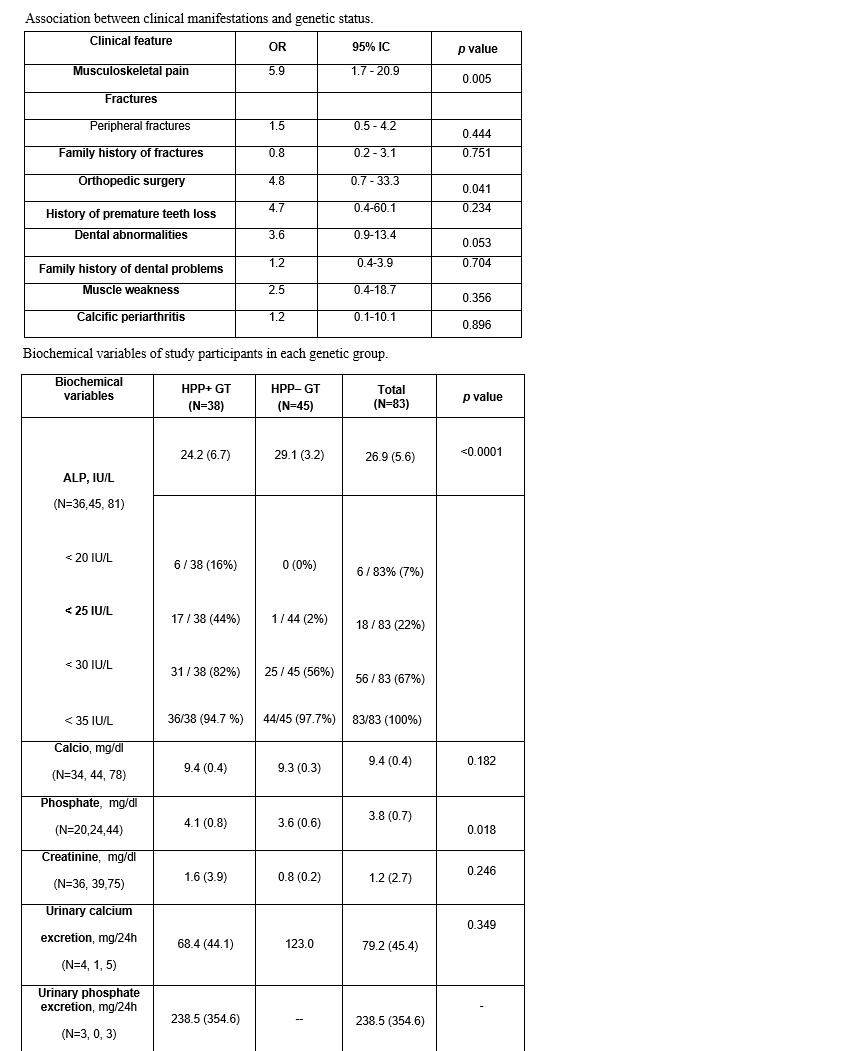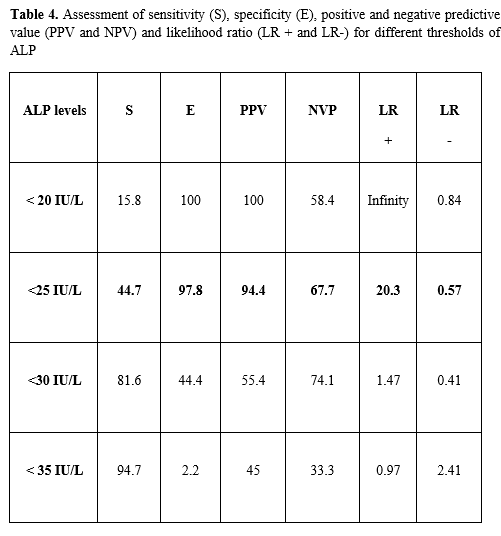Session Information
Date: Tuesday, November 12, 2019
Title: Osteoporosis & Metabolic Bone Disease – Basic & Clinical Science Poster
Session Type: Poster Session (Tuesday)
Session Time: 9:00AM-11:00AM
Background/Purpose: Hypophosphatasia (HPP) is caused by mutations in ALPL, resulting in low alkaline phosphatase (ALP) levels. The determination of ALPL mutation may not be accessible in clinical practice. In this case, an alternative simple method to predict the presence or absence of the mutation would be very useful. This study aimed to characterize the main clinical and laboratory features associated with the presence (HPP + GT) or absence (HPP – GT) of mutations in the ALPL gene among subjects with persistently low ALP levels.
Methods: During this cross-sectional study, the laboratory reports from 386,353 people attending a Tertiary University Hospital from 2009 to 2015 were screened. 109 adult subjects with persistently low ALP values (≥2 measurements below or equal to 35 IU/L and none above 45 IU/L) were enrolled and 85 gave their consent for genetic testing. During one visit, a systematized questionnaire was performed to retrieve demographic, clinical and laboratory data and a genetic test to detect HPP was performed. Comparisons between groups were performed using the Student’s t-test for unpaired data, if normally distributed; or Mann-Whitney U test, if not normally distributed. Logistic regression models adjusted for confounders were employed to investigate the association between clinical and laboratory characteristics and the presence/absence or ALPL mutation.
Results: Forty-seven percent (40/85) of subjects showed mutations in ALPL: 75% (30/40) were heterozygous for a pathogenic variant, 17.5% (7/40) for a likely pathogenic variant, 5% (2/40) for a variant of unknown significance (VUS) and one patient diagnosed of infantile HPP harbored compound heterozygous mutations. Demographic characteristics are shown in table 1. The presence of mutation was significantly associated with the presence of musculoskeletal pain (OR: 5.9; 95% IC: 1.7-20.5) and orthopedic surgery (OR: 4.8; 95% IC: 0.7-33.3). Metatarsal stress fractures were also more frequent in the HPP + GT group (4 vs 0, p=0.007). In terms of laboratory paramethers, ALP levels were lower in the HPP + GT group compared with HPP –GT group (24.2 vs 29.1 IU/L, p < 0.0001; respectively). Interestingly, levels below 25 UI/L showed a specificity of 97.8% and a positive predictive value of 94.4% to detect a positive genetic test.
Conclusion: In our cohort, ALP levels below 25 IU/L were identified as a very good predictor for the presence of mutations in ALPL. Furthermore, the presence of musculoskeletal pain and previous orthopedic surgery were also associated to a positive genetic test.
To cite this abstract in AMA style:
Tornero C, Navarro-Compán V, Tenorio J, García S, Buño A, Monjo I, Plasencia C, Iturzaeta J, Lapunzina P, Heath K, Balsa A, Aguado P. Can We Predict Hypophosphatasia-Mutation Result Based on Alkaline Phosphatase Serum Levels? [abstract]. Arthritis Rheumatol. 2019; 71 (suppl 10). https://acrabstracts.org/abstract/can-we-predict-hypophosphatasia-mutation-result-based-on-alkaline-phosphatase-serum-levels/. Accessed .« Back to 2019 ACR/ARP Annual Meeting
ACR Meeting Abstracts - https://acrabstracts.org/abstract/can-we-predict-hypophosphatasia-mutation-result-based-on-alkaline-phosphatase-serum-levels/



